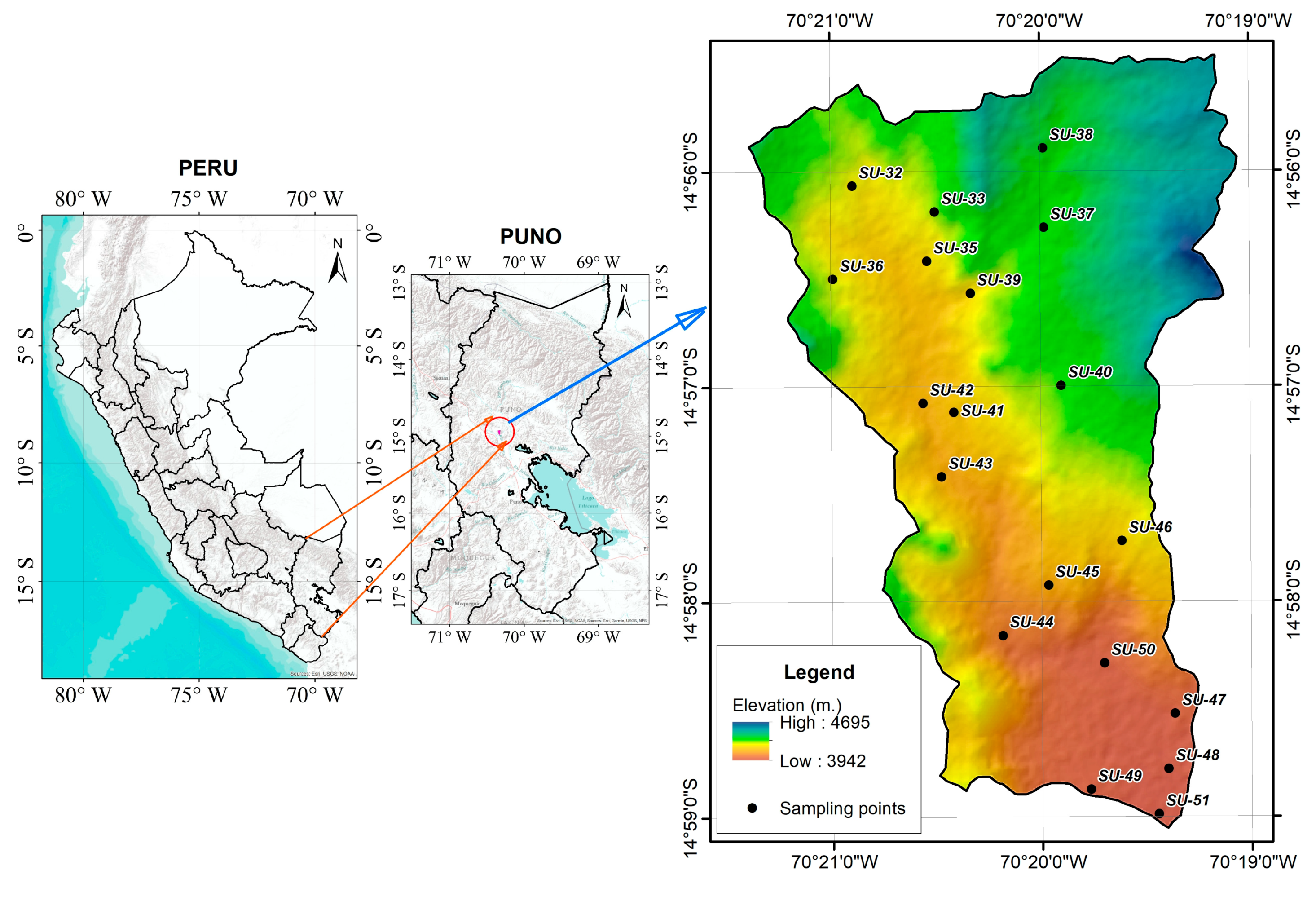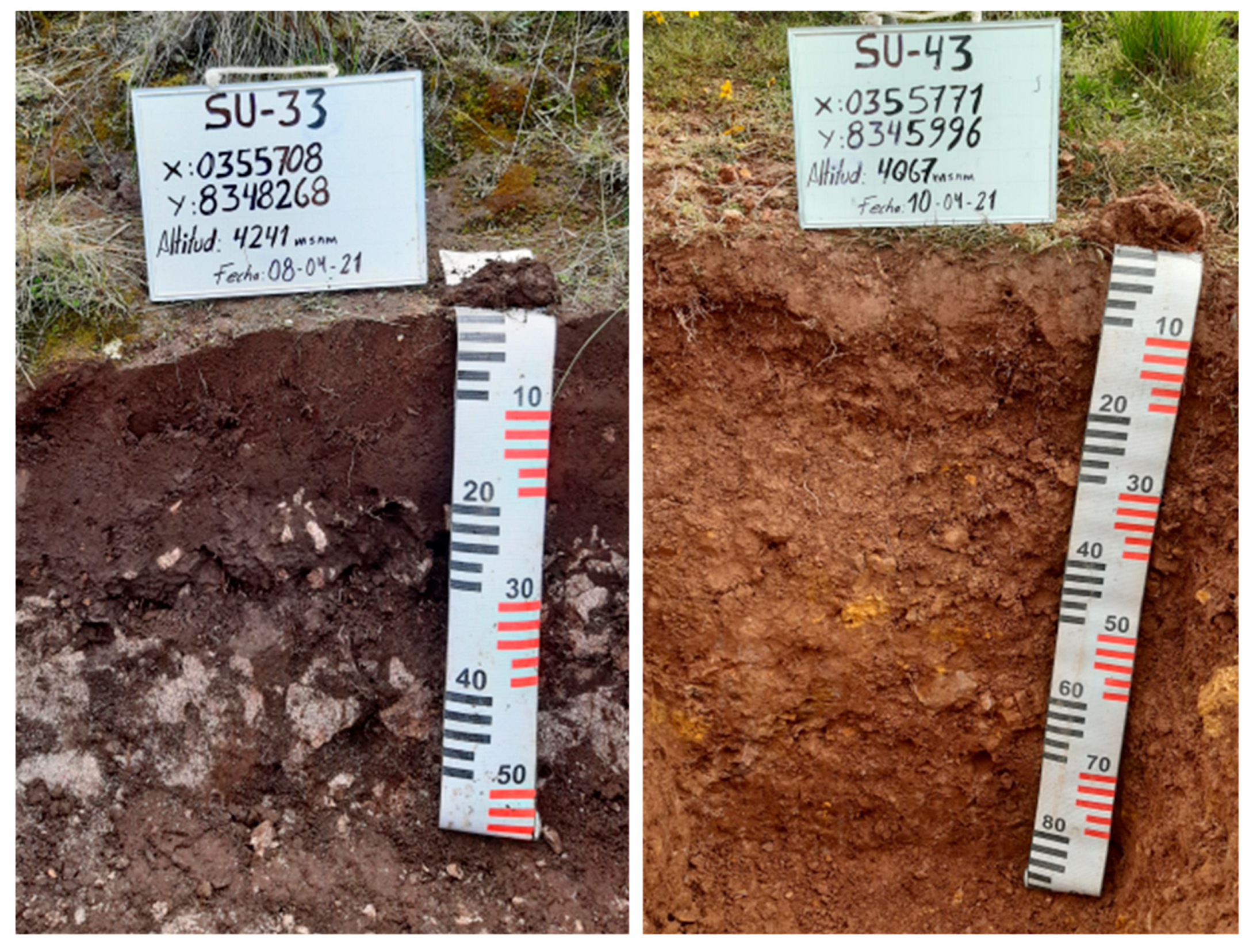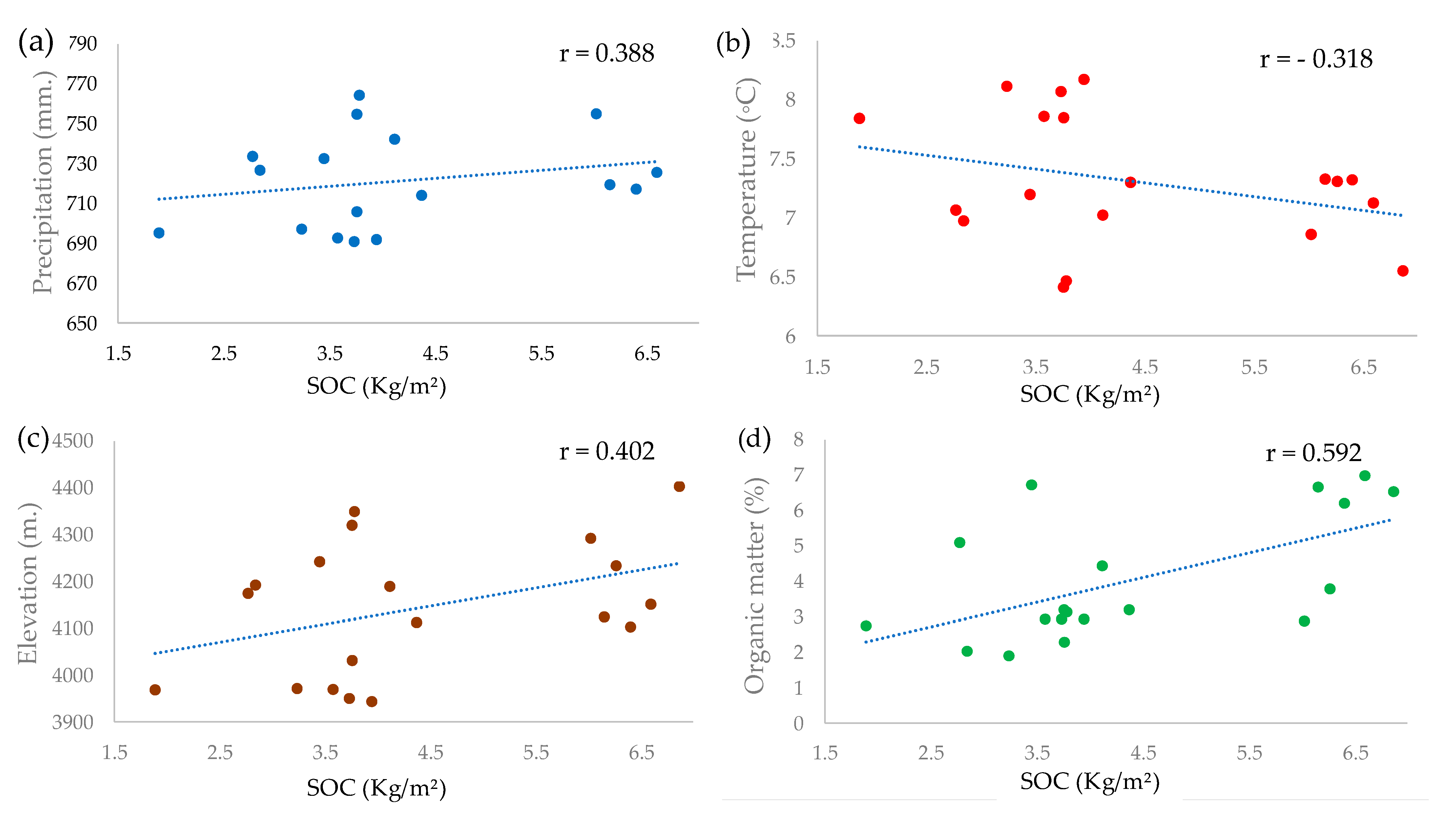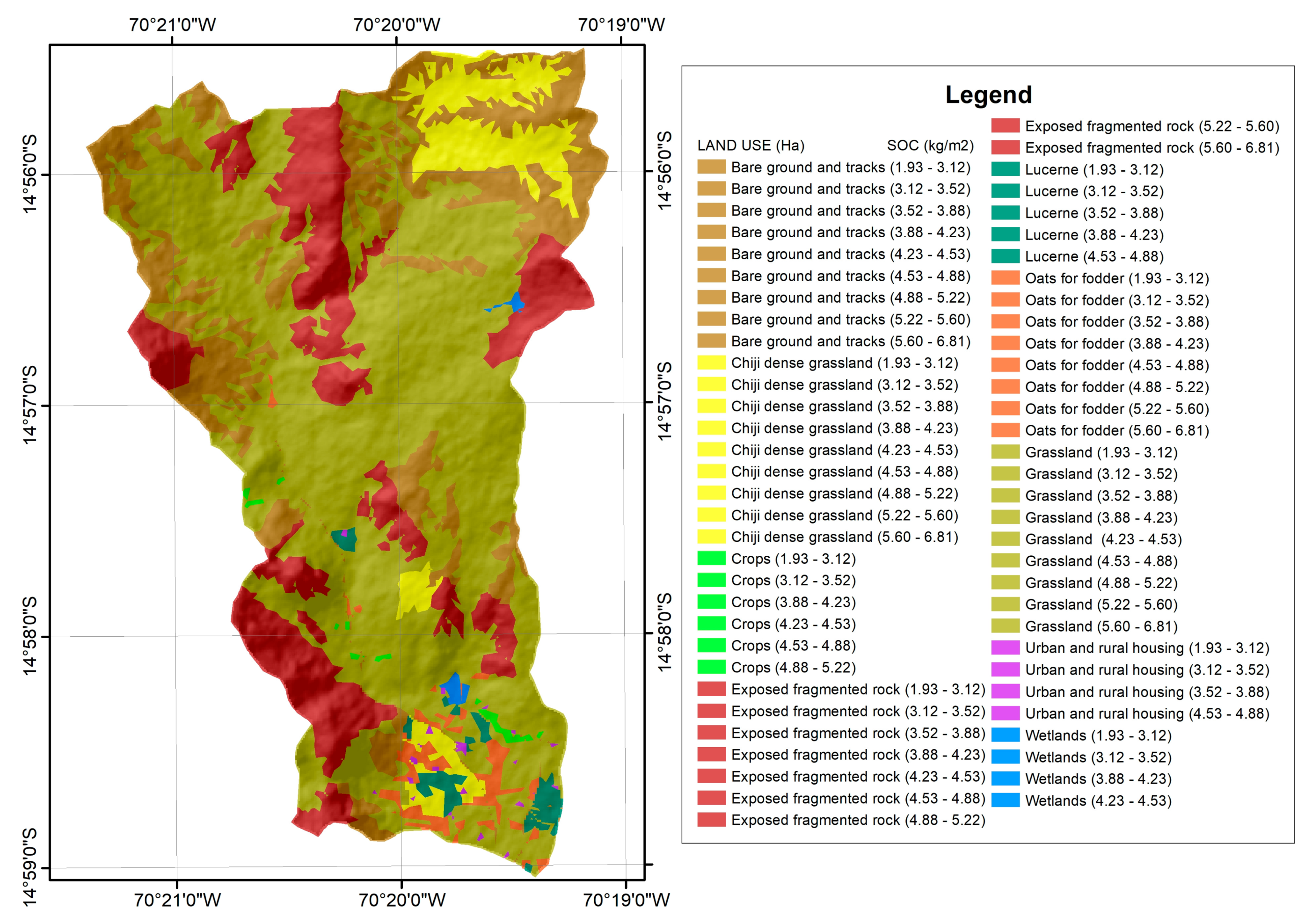Spatial Distribution of Soil Organic Carbon in Relation to Land Use, Based on the Weighted Overlay Technique in the High Andean Ecosystem of Puno—Peru
Abstract
1. Introduction
2. Materials and Methods
2.1. Study Site
2.2. SOC, Environmental Variables, and Climatic Data Processing Workflow
2.3. Soil Organic Carbon (SOC) Estimation
2.4. Geostatistical Analysis and SOC Prediction by Ordinary Kriging
2.5. Climate Data Processing
2.6. Landsat 8 OLI Data Processing
2.7. Pearson Correlation SOC, Environmental Variables, and Climate Data
2.8. Terrain Attribute Derivation
2.9. Weighted Overlay Technique
3. Results
3.1. Spatial Distribution of Soil Organic Carbon
3.2. Environmental and Climate Data Variables on Soil Organic Carbon
3.3. Modelling of Soil Organic Carbon Weighted Overlay Technique
3.4. Land Use and SOC Spatial Distribution
4. Discussion
4.1. Vegetation Cover
4.2. Geostatistical Analysis
5. Conclusions
Author Contributions
Funding
Institutional Review Board Statement
Informed Consent Statement
Data Availability Statement
Acknowledgments
Conflicts of Interest
References
- Dhakal, S.; Koirala, M. Effect of Land Use Change on Soil Organic Carbon Stock in Balkhu Khola Watershed Southwestern Part of Kathmandu Valley, Central Nepal ClimateHimalaya View Project Development of Sustainable Energy for Rangelands in the HKH Region View Project Eklabya Sharma International Centre for Integrated Mountain Development. In Proceedings of the WASET ICEESD 2010: International Conference on Energy, Environment, Sustainable Development, Paris, France, 28 June 2010. [Google Scholar] [CrossRef]
- Žížala, D.; Minarík, R.; Zádorová, T. Soil Organic Carbon Mapping Using Multispectral Remote Sensing Data: Prediction Ability of Data with Different Spatial and Spectral Resolutions. Remote Sens. 2019, 11, 2947. [Google Scholar] [CrossRef]
- Pandian, E.; Ravichandran, P. Altitudinal Variation of Soil Organic Carbon Stock in Tropical Forest of Courtallam Hills, Southern Western Ghats of India. Trop. Plant Res. 2020, 7, 702–714. [Google Scholar] [CrossRef]
- Gebrehiwot, K.; Desalegn, T.; Woldu, Z.; Demissew, S.; Teferi, E. Soil Organic Carbon Stock in Abune Yosef Afroalpine and Sub-Afroalpine Vegetation, Northern Ethiopia. Ecol. Process. 2018, 7, 1–9. [Google Scholar] [CrossRef]
- Gross, C.D.; Harrison, R.B. The Case for Digging Deeper: Soil Organic Carbon Storage, Dynamics, and Controls in Our Changing World. Soil Syst. 2019, 3, 28. [Google Scholar] [CrossRef]
- Hobley, E.; Baldock, J.; Hua, Q.; Wilson, B. Land-Use Contrasts Reveal Instability of Subsoil Organic Carbon. Glob. Chang. Biol. 2017, 23, 955–965. [Google Scholar] [CrossRef]
- Ontl, T.A.; Aa, A.A. Soil Carbon Storage. Nat. Educ. Knowl. 2012, 3, 35. [Google Scholar]
- Wiltshire, S.; Beckage, B. Soil Carbon Sequestration through Regenerative Agriculture in the U.S. State of Vermont. PLoS Clim. 2022, 1, e0000021. [Google Scholar] [CrossRef]
- Li, X.; McCarty, G.W.; Du, L.; Lee, S. Use of Topographic Models for Mapping Soil Properties and Processes. Soil Syst. 2020, 4, 32. [Google Scholar] [CrossRef]
- Schimel, D.S.; House, J.I.; Hibbard, K.A.; Bousquet, P.; Ciais, P.; Peylin, P.; Braswell, B.H.; Apps, M.J.; Baker, D.; Bondeau, A.; et al. Recent Patterns and Mechanisms of Carbon Exchange by Terrestrial Ecosystems. Nature 2001, 414, 169–172. [Google Scholar] [CrossRef]
- Zhu, A.X.; Liu, J.; Du, F.; Zhang, S.J.; Qin, C.Z.; Burt, J.; Behrens, T.; Scholten, T. Predictive Soil Mapping with Limited Sample Data. Eur. J. Soil. Sci. 2015, 66, 535–547. [Google Scholar] [CrossRef]
- Ferraz, A.; Saatchi, S.; Mallet, C.; Jacquemoud, S.; Gonçalves, G.; Silva, C.A.; Soares, P.; Tomé, M.; Pereira, L. Airborne Lidar Estimation of Aboveground Forest Biomass in the Absence of Field Inventory. Remote Sens. 2016, 8, 653. [Google Scholar] [CrossRef]
- Kumar, S. Soil Organic Carbon Mapping at Field and Regional Scales Using GIS and Remote Sensing Applications. Adv. Crop Sci. Technol. 2013, 1, 1. [Google Scholar] [CrossRef]
- Man, W.; Yu, H.; Li, L.; Liu, M.; Mao, D.; Ren, C.; Wang, Z.; Jia, M.; Miao, Z.; Lu, C.; et al. Spatial Expansion and Soil Organic Carbon Storage Changes of Croplands in the Sanjiang Plain, China. Sustainability 2017, 9, 563. [Google Scholar] [CrossRef]
- Chai, X.; Shen, C.; Yuan, X.; Huang, Y. Spatial Prediction of Soil Organic Matter in the Presence of Different External Trends with REML-EBLUP. Geoderma 2008, 148, 159–166. [Google Scholar] [CrossRef]
- Minasny, B.; McBratney, A.B. The Matérn Function as a General Model for Soil Variograms. Geoderma 2005, 128, 192–207. [Google Scholar] [CrossRef]
- Zhang, Z.; Zhou, Y.; Huang, X. Applicability of GIS-Based Spatial Interpolation and Simulation for Estimating the Soil Organic Carbon Storage in Karst Regions. Glob. Ecol. Conserv. 2020, 21, e00849. [Google Scholar] [CrossRef]
- Yang, L.; Luo, P.; Wen, L.; Li, D. Soil Organic Carbon Accumulation during Post-Agricultural Succession in a Karst Area, Southwest China. Sci. Rep. 2016, 6, 1–8. [Google Scholar] [CrossRef]
- Bhunia, G.S.; Shit, P.K.; Maiti, R. Comparison of GIS-Based Interpolation Methods for Spatial Distribution of Soil Organic Carbon (SOC). J. Saudi Soc. Agric. Sci. 2018, 17, 114–126. [Google Scholar] [CrossRef]
- Ye, H.; Huang, W.; Huang, S.; Huang, Y.; Zhang, S.; Dong, Y.; Chen, P. Effects of Different Sampling Densities on Geographically Weighted Regression Kriging for Predicting Soil Organic Carbon. Spat. Stat. 2017, 20, 76–91. [Google Scholar] [CrossRef]
- Mondal, A.; Khare, D.; Kundu, S.; Mondal, S.; Mukherjee, S.; Mukhopadhyay, A. Spatial Soil Organic Carbon (SOC) Prediction by Regression Kriging Using Remote Sensing Data. Egypt. J. Remote Sens. Space Sci. 2017, 20, 61–70. [Google Scholar] [CrossRef]
- Fang, X.; Xue, Z.; Li, B.; An, S. Soil Organic Carbon Distribution in Relation to Land Use and Its Storage in a Small Watershed of the Loess Plateau, China. Catena 2012, 88, 6–13. [Google Scholar] [CrossRef]
- Lal, R. Soil Carbon Sequestration Impacts on Global Climate Change and Food Security. Science 2004, 304, 1623–1627. [Google Scholar] [CrossRef]
- Calizaya, E.; Laqui, W.; Sardón, S.; Calizaya, F.; Cuentas, O.; Cahuana, J.; Min-5 Dani, C.; Huacani, W. Snow Cover Temporal Dynamic Using MODIS Product, and Its 2 Relationship with Precipitation and Temperature in the Tropi-3 Cal Andean Glaciers in the Alto Santa Sub-Basin (Peru) 4. Sustainability 2023, 15, 7610. [Google Scholar] [CrossRef]
- Tovar, C.; Seijmonsbergen, A.C.; Duivenvoorden, J.F. Monitoring land use and land cover change in mountain regions: An example in the Jalca grasslands of the Peruvian Andes. Landsc. Urban Plan. 2013, 112, 40–49. [Google Scholar] [CrossRef]
- Galán-De-mera, A.; Campos-De-la-cruz, J.; Linares-Perea, E.; Montoya-Quino, J.; Torres-Marquina, I.; Vicente-Orellana, J.A. A Phytosociological Study on Andean Rainforests of Peru, and a Comparison with the Surrounding Countries. Plants 2020, 9, 1654. [Google Scholar] [CrossRef] [PubMed]
- Alberto, J.; Becerra, B.; Dantas Bitencourt, M.; Bustamante, J.A.B.; Bitencourt, M.D. Ecological Zoning of an Andean Grasslands (Puna) at the Manu Biosphere Reserve, Peru. Int. J. Environ. Sustain. Dev. 2007, 6, 357–372. [Google Scholar]
- De la Cruz Bustamante, N.S. Geología de Los Cuadrángulos de Velille, Yauri, Ayaviri y Azángaro, Hojas: 30-s, 30-t, 30-u y 30-v–[Boletín A 58]. 1995. Available online: https://repositorio.ingemmet.gob.pe/handle/20.500.12544/179 (accessed on 12 May 2023).
- MIDAGRI Reglamento Para La Ejecución de Levantamiento de Suelos. 2010. Available online: https://www2.congreso.gob.pe/sicr/cendocbib/con2_uibd.nsf/5E437D4A059A261F052575C4006BE90D/$FILE/ds033_85_ag_reglamento_eje_levantamiento_suelos.pdf (accessed on 30 May 2023).
- Shamrikova, E.V.; Kondratenok, B.M.; Tumanova, E.A.; Vanchikova, E.V.; Lapteva, E.M.; Zonova, T.V.; Lu-Lyan-Min, E.I.; Davydova, A.P.; Libohova, Z.; Suvannang, N. Transferability between Soil Organic Matter Measurement Methods for Database Harmonization. Geoderma 2022, 412, 115547. [Google Scholar] [CrossRef]
- Penman, J.; Gytarsky, K.S.K.K. Intergovernmental Panel on Climate Change. National Greenhouse Gas Inventories Programme. In Good Practice Guidance for Land Use, Land-Use Change and Forestry; Institute for Global Environmental Strategies for the IPCC: Geneva, Switzerland, 2003; ISBN 4887880030. [Google Scholar]
- John, K.; Abraham, I.I.; Kebonye, N.M.; Agyeman, P.C.; Ayito, E.O.; Kudjo, A.S. Soil Organic Carbon Prediction with Terrain Derivatives Using Geostatistics and Sequential Gaussian Simulation. J. Saudi Soc. Agric. Sci. 2021, 20, 379–389. [Google Scholar] [CrossRef]
- Bangroo, S.A.; Bhat, M.I.; Wani, J.A.; Rasool, R.; Madhi, S.S.; Bashir, O.; Shah, T.I. Mapping Soil Properties Using Geostatistical Methods for Mid to High Altitude Temperate Zone of Kashmir Himalayas. J. Indian Soc. Soil Sci. 2023, 71, 1–12. [Google Scholar] [CrossRef]
- Chabala, L.M.; Mulolwa, A.; Lungu, O. Application of Ordinary Kriging in Mapping Soil Organic Carbon in Zambia. Pedosphere 2017, 27, 338–343. [Google Scholar] [CrossRef]
- Dai, F.; Zhou, Q.; Lv, Z.; Wang, X.; Liu, G. Spatial Prediction of Soil Organic Matter Content Integrating Artificial Neural Network and Ordinary Kriging in Tibetan Plateau. Ecol. Indic. 2014, 45, 184–194. [Google Scholar] [CrossRef]
- Ke, Y.; Im, J.; Lee, J.; Gong, H.; Ryu, Y. Characteristics of Landsat 8 OLI-Derived NDVI by Comparison with Multiple Satellite Sensors and in-Situ Observations. Remote Sens. Environ. 2015, 164, 298–313. [Google Scholar] [CrossRef]
- Zaitunah, A.; Samsuri, S.; Ahmad, A.; Safitri, R. Normalized difference vegetation index (ndvi) analysis for land cover types using landsat 8 oli in besitang watershed, Indonesia. IOP Conf. Ser. Earth Environ. Sci. 2018, 126, 012112. [Google Scholar] [CrossRef]
- Carré, F.; Girard, M.C. Quantitative mapping of soil types based on regression kriging of taxonomic distances with landform and land cover attributes. Geoderma 2002, 110, 241–263. [Google Scholar] [CrossRef]
- Gibson, A.J.; Hancock, G.R.; Bretreger, D.; Cox, T.; Hughes, J.; Kunkel, V. Assessing Digital Elevation Model Resolution for Soil Organic Carbon Prediction. Geoderma 2021, 398, 115106. [Google Scholar] [CrossRef]
- Wang, H.; Zhang, X.; Wu, W.; Liu, H. Prediction of Soil Organic Carbon under Different Land Use Types Using Sentinel-1/-2 Data in a Small Watershed. Remote Sens. 2021, 13, 1229. [Google Scholar] [CrossRef]
- Nguyen, H.T.G.; Lyttek, E.; Lal, P.; Wieczerak, T.; Luong, T. Evaluating Loblolly Pine Bioenergy Development Potential Using AHP Integrated Weighted Overlay and Network Optimization in Virginia, USA. Trees For. People 2022, 8, 100271. [Google Scholar] [CrossRef]
- Almulla, A.A.; Jones, D.; Roberts, P. Substrate Influences Temperature Sensitivity of Dissolved Organic Carbon (DOC) and Nitrogen (DON) Mineralization in Arid Agricultural Soils. Soil. Syst. 2018, 2, 28. [Google Scholar] [CrossRef]
- Choudhary, B.K.; Majumdar, K.; Datta, B.K. Effects of Land Use on the Soil Organic Carbon Storage Potentiality and Soil Edaphic Factors in Tripura, Northeast India. Am. J. Clim. Chang. 2016, 5, 417–429. [Google Scholar] [CrossRef]
- Jakšić, S.; Ninkov, J.; Milić, S.; Vasin, J.; Živanov, M.; Perović, V.; Banjac, B.; Vučković, S.; Dozet, G.; Komlen, V. Topographic Position, Land Use and Soil Management Effects on Soil Organic Carbon (Vineyard Region of Niš, Serbia). Agronomy 2021, 11, 1438. [Google Scholar] [CrossRef]
- Florez Martínez, A. Manual de Pastos y Forrajes Altoandinos; UNAlm: Lima, Peru, 2005; ISBN 9972471152. Available online: https://funsepa.net/soluciones/pubs/MjY=.pdf (accessed on 14 May 2023).
- Solano, M.; Ramón, P.; Gusmán, E.; Burneo, J.I.; Quichimbo, P.; Jiménez, L.; Solano, M.; Ramón, P.; Gusmán-M, E.; Burneo, J.I.; et al. Effect of the Altitudinal Gradient on Soil Carbon and Nitrogen Reserves in a Dry Scrub in Ecuador. Ecosistemas 2018, 27, 116–122. [Google Scholar]
- Hunt, J.G.; Celestina, C.; Kirkegaard, J.A. The Realities Of Climate Change, Conservation Agriculture and Soil Carbon Sequestration. Glob. Chang. Biol. 2020, 6, 3188–3189. [Google Scholar] [CrossRef]
- Maja, M.; Ranko, Č. Bishal Sitaula Soil Organic Carbon in Serbian Mountain Soils: Effects of Land Use and Altitude. Pol. J. Environ. Stud. 2010, 20, 977. [Google Scholar]
- Huamán-Carrión, M.L.; Espinoza-Montes, F.; Barrial-Lujan, A.I.; Ponce-Atencio, Y. Influence of Altitude and Soil Characteristics on Organic Carbon Storage Capacity of High Andean Natural Pastures. Sci. Agropecu. 2021, 12, 83–90. [Google Scholar] [CrossRef]
- Nabiollahi, K.; Shahlaee, S.; Zahedi, S.; Taghizadeh-Mehrjardi, R.; Kerry, R.; Scholten, T. Land Use and Soil Organic Carbon Stocks—Change Detection over Time Using Digital Soil Assessment: A Case Study from Kamyaran Region, Iran (1988–2018). Agronomy 2021, 11, 597. [Google Scholar] [CrossRef]
- Witing, F.; Volk, M.; Franko, U. Modeling Soil Organic Carbon Dynamics of Arable Land across Scales: A Simplified Assessment of Alternative Management Practices on the Level of Administrative Units. Agronomy 2023, 13, 1159. [Google Scholar] [CrossRef]
- Lis-Gutiérrez, M.; Rubiano-Sanabria, Y.; Usuga, J.C.L. Soils and Land Use in the Study of Soil Organic Carbon in Colombian Highlands Catena. Acta Univ. Carol. Geogr. 2019, 54, 15–23. [Google Scholar] [CrossRef]
- Food and Agriculture Organization of the United Nations. Sistemas de Uso de La Tierra En Los Trópicos Húmedos y La Emisión y Secuestro de CO2; FAO: Rome, Italy, 2000; ISBN 92-5-304412-8. [Google Scholar]
- Yang, Y.Y.; Goldsmith, A.; Herold, I.; Lecha, S.; Toor, G.S. Assessing Soil Organic Carbon in Soils to Enhance and Track Future Carbon Stocks. Agronomy 2020, 10, 1139. [Google Scholar] [CrossRef]
- Fathizad, H.; Taghizadeh-Mehrjardi, R.; Hakimzadeh Ardakani, M.A.; Zeraatpisheh, M.; Heung, B.; Scholten, T. Spatiotemporal Assessment of Soil Organic Carbon Change Using Machine-Learning in Arid Regions. Agronomy 2022, 12, 628. [Google Scholar] [CrossRef]
- Beltrán-Dávalos, A.A.; Ayala Izurieta, J.E.; Echeverria Guadalupe, M.M.; Van Wittenberghe, S.; Delegido, J.; Otero Pérez, X.L.; Merino, A. Evaluation of Soil Organic Carbon Storage of Atillo in the Ecuadorian Andean Wetlands. Soil. Syst. 2022, 6, 92. [Google Scholar] [CrossRef]
- Paz, F.; Etchevers, J. Distribución a Profundidad del Carbono Orgánico en Los Suelos de México. Terra Latinoam. 2016. Available online: http://www.scielo.org.mx/scielo.php?script=sci_arttext&pid=S0187-57792016000300339&lng=es&nrm=iso (accessed on 16 June 2023).
- Acosta-Mireles, M.; Paz-Pellat, F.; Hidalgo-Moreno, C.; Etchevers-Barra, J.D. Soil Organic Carbon Depth Distribution Patterns in Different Land Uses and Management. Terra Latinoam. 2022, 40, 1321. [Google Scholar] [CrossRef]
- Laganière, J.; Augusto, L.; Hatten, J.A.; Spielvogel, S. Editorial: Vegetation Effects on Soil Organic Matter in Forested Ecosystems; Frontiers in Forests and Global Change: Lausanne, Switzerland, 2022; Volume 4. [Google Scholar]
- Batjes, N.H. Harmonized Soil Property Values for Broad-Scale Modelling (WISE30sec) with Estimates of Global Soil Carbon Stocks. Geoderma 2016, 269, 61–68. [Google Scholar] [CrossRef]
- Castañeda-Martín, A.E.; Montes-Pulido, C.R. Carbono Almacenado En Páramo Andino. Entramado 2017, 13, 210–221. [Google Scholar] [CrossRef]
- Wiltshire, S.; Grobe, S.; Beckage, B. A Historically Driven Spinup Procedure for Soil Carbon Modeling. Soil Syst. 2023, 7, 35. [Google Scholar] [CrossRef]
- Arumugam, T.; Kinattinkara, S.; Velusamy, S.; Shanmugamoorthy, M.; Murugan, S. GIS Based Landslide Susceptibility Mapping and Assessment Using Weighted Overlay Method in Wayanad: A Part of Western Ghats, Kerala. Urban Clim. 2023, 49, 101508. [Google Scholar] [CrossRef]
- Wang, F.; Wang, X.; Yao, B.; Zhang, Z.; Shi, G.; Ma, Z.; Chen, Z.; Zhou, H. Effects of Land-Use Types on Soil Organic Carbon Stocks: A Case Study across an Altitudinal Gradient within a Farm-Pastoral Area on the Eastern Qinghai-Tibetan Plateau, China. J. Mt. Sci. 2018, 15, 2693–2702. [Google Scholar] [CrossRef]
- Francaviglia, R.; Almagro, M.; Vicente-Vicente, J.L. Conservation Agriculture and Soil Organic Carbon: Principles, Processes, Practices and Policy Options. Soil. Syst. 2023, 7, 17. [Google Scholar] [CrossRef]
- Gerke, J. The Central Role of Soil Organic Matter in Soil Fertility and Carbon Storage. Soil Syst. 2022, 6, 33. [Google Scholar] [CrossRef]








| Information | Type of Data | Spatial Resolution (m) | Source | Link |
|---|---|---|---|---|
| Digital Elevation Model | Raster | 12.5 | Open Science Earthdata (NASA) | ASF Data Search (https://www.alaska.edu; accessed on 4 February 2023) |
| Satellite image: Landsat 8 (Bands 4 and 5) | Raster | 30 | United States Geological Survey (USGS) | EarthExplorer (https://earthexplorer.usgs.gov/; accessed on 10 February 2023) |
| Precipitation (mm) | Raster | 100 | Servicio Nacional de Meteorología e Hidrología del Perú (SENAMHI) | https://www.gob.pe/senamhi accessed on 8 March 2023 |
| Temperature (°C) | Raster | 100 | Servicio Nacional de Meteorología e Hidrología del Perú (SENAMHI) | https://www.gob.pe/senamhi accessed on 8 March 2023 |
| Sample | UTM–WGS84–19S (m) | SOC (Kg/m2)–Depths | ||||
|---|---|---|---|---|---|---|
| East | North | Elevation | 0–20 cm | 20–45 cm | 45–105 cm | |
| SU-31 | 355,363 | 8,347,490 | 4113 | - | - | 13.37 |
| SU-32 | 355,002 | 8,348,489 | 4202 | 6.27 | 1.95 | 1.45 |
| SU-33 | 355,708 | 8,348,268 | 4241 | 6.03 | - | - |
| SU-35 | 355,641 | 8,347,846 | 4143 | 4.12 | 3.35 | 1.62 |
| SU-36 | 354,838 | 8,347,688 | 4209 | 3.45 | - | 0.19 |
| SU-37 | 356,642 | 8,348,136 | 4303 | 3.78 | 2.32 | 4.60 |
| SU-38 | 356,635 | 8,348,817 | 4349 | 6.87 | 1.68 | 2.95 |
| SU-39 | 356,016 | 8,347,571 | 4152 | 2.84 | 4.18 | 11.14 |
| SU-40 | 356,794 | 8,346,781 | 4271 | 3.76 | 2.33 | 1.10 |
| SU-41 | 355,876 | 8,346,548 | 4111 | 6.60 | 2.70 | 1.02 |
| SU-42 | 355,611 | 8,346,625 | 4068 | 6.16 | 2.98 | 1.80 |
| SU-43 | 355,771 | 8,345,996 | 4067 | 4.37 | 0.80 | 0.94 |
| SU-44 | 356,297 | 8,344,639 | 3984 | 3.76 | 0.92 | 0.29 |
| SU-45 | 356,688 | 8,345,069 | 4066 | 6.41 | 1.18 | 0.79 |
| SU-46 | 357,315 | 8,345,451 | 4134 | 2.77 | 3.08 | 1.97 |
| SU-47 | 357,772 | 8,343,974 | 3929 | 3.58 | - | 0.17 |
| SU-48 | 357,718 | 8,343,501 | 3898 | 3.73 | - | 1.31 |
| SU-49 | 357,054 | 8,343,322 | 3907 | 3.24 | 0.79 | 0.84 |
| SU-50 | 357,167 | 8,344,407 | 3967 | 1.89 | 1.33 | 4.40 |
| SU-51 | 357,636 | 8,343,113 | 3895 | 3.95 | 1.30 | 3.50 |
| Sample Point | SOC (Kg/m2) | Pp. (mm) | Tem. (°C) | Elevation (m) | OM (%) |
|---|---|---|---|---|---|
| SU-32 | 6.869 | 764.55 | 6.55 | 4403 | 6.54 |
| SU-33 | 6.268 | 738.64 | 7.31 | 4233 | 3.79 |
| SU-35 | 6.027 | 755.10 | 6.86 | 4292 | 2.88 |
| SU-36 | 3.783 | 764.37 | 6.47 | 4349 | 3.14 |
| SU-37 | 4.118 | 742.34 | 7.02 | 4189 | 4.44 |
| SU-38 | 3.450 | 732.60 | 7.20 | 4242 | 6.73 |
| SU-39 | 2.842 | 726.80 | 6.97 | 4192 | 2.03 |
| SU-40 | 3.759 | 754.93 | 6.41 | 4320 | 3.20 |
| SU-41 | 6.598 | 725.68 | 7.13 | 4151 | 6.99 |
| SU-42 | 6.156 | 719.53 | 7.33 | 4124 | 6.67 |
| SU-43 | 4.373 | 714.14 | 7.30 | 4112 | 3.20 |
| SU-44 | 2.772 | 733.68 | 7.07 | 4174 | 5.10 |
| SU-45 | 6.405 | 717.29 | 7.32 | 4103 | 6.21 |
| SU-46 | 3.761 | 705.97 | 7.85 | 4031 | 2.29 |
| SU-47 | 1.888 | 695.25 | 7.84 | 3968 | 2.75 |
| SU-48 | 3.579 | 692.71 | 7.86 | 3969 | 2.94 |
| SU-49 | 3.734 | 690.91 | 8.07 | 3950 | 2.94 |
| SU-50 | 3.238 | 697.23 | 8.12 | 3971 | 1.90 |
| SU-51 | 3.946 | 691.88 | 8.17 | 3943 | 2.94 |
| Variables | SOC (r) | Weighting (1 to 9) | Weighted Overlay (%) |
| SOC | 1 to 9 | 50 | |
| Precipitation | 0.388 | 1 to 9 | 10 |
| Temperature | −0.318 | 9 to 1 | 10 |
| Land use | - | 1 to 9 | 20 |
| Elevation | 0.402 | 1 to 9 | 10 |
| Organic matter | 0.592 | - | |
| Slope | - | 1 to 8 | |
| Total | 100% |
| SOC (Kg/m2)–Depths (cm) | Variables | Climate Data | |||||
|---|---|---|---|---|---|---|---|
| 0–20 | 20–45 | 45–105 | Land Use | Slope (%) | Precipitation | Temperature | W |
| 1.93–3.12 | 0.79–1.20 | 0.87–1.19 | Exposed fragmented rock | 0–2 | 689.55–701.32 | 7.95–8.17 | 1 |
| 3.12–3.52 | 1.20–1.57 | 1.19–1.37 | Urban and rural housing | 2–4 | 701.32–714.02 | 7.64–7.95 | 2 |
| 3.52–3.88 | 1.57–1.97 | 1.37–1.50 | Bare ground and tracks | 4–8 | 714.02–726.25 | 7.36–7.64 | 3 |
| 3.88–4.23 | 1.97–2.25 | 1.50–1.61 | Pajonales | 8–15 | 726.25–737.88 | 7.13–7.36 | 4 |
| 4.23–4.53 | 2.25–2.46 | 1.61–1.72 | Lucerne | 15–25 | 737.88–748.72 | 6.86–7.13 | 5 |
| 4.53–4.88 | 2.46–2.71 | 1.72–1.85 | Chiji dense grassland | 25–50 | 748.72–760.85 | 6.58–6.86 | 6 |
| 4.88–5.22 | 2.71–3.06 | 1.85–2.04 | Oats for fodder | 50–75 | 760.85–773.84 | 6.31–6.58 | 7 |
| 5.22–5.60 | 3.06–3.47 | 2.04–2.34 | Wetlands | >75 | 773.84–788.42 | 6.01–6.31 | 8 |
| 5.60–6.81 | 3.47–4.17 | 2.34–2.65 | Crops | - | 788.42–823.91 | 5.63–6.01 | 9 |
Disclaimer/Publisher’s Note: The statements, opinions and data contained in all publications are solely those of the individual author(s) and contributor(s) and not of MDPI and/or the editor(s). MDPI and/or the editor(s) disclaim responsibility for any injury to people or property resulting from any ideas, methods, instructions or products referred to in the content. |
© 2023 by the authors. Licensee MDPI, Basel, Switzerland. This article is an open access article distributed under the terms and conditions of the Creative Commons Attribution (CC BY) license (https://creativecommons.org/licenses/by/4.0/).
Share and Cite
Canaza, D.; Calizaya, E.; Chambi, W.; Calizaya, F.; Mindani, C.; Cuentas, O.; Caira, C.; Huacani, W. Spatial Distribution of Soil Organic Carbon in Relation to Land Use, Based on the Weighted Overlay Technique in the High Andean Ecosystem of Puno—Peru. Sustainability 2023, 15, 10316. https://doi.org/10.3390/su151310316
Canaza D, Calizaya E, Chambi W, Calizaya F, Mindani C, Cuentas O, Caira C, Huacani W. Spatial Distribution of Soil Organic Carbon in Relation to Land Use, Based on the Weighted Overlay Technique in the High Andean Ecosystem of Puno—Peru. Sustainability. 2023; 15(13):10316. https://doi.org/10.3390/su151310316
Chicago/Turabian StyleCanaza, Daniel, Elmer Calizaya, Walter Chambi, Fredy Calizaya, Carmen Mindani, Osmar Cuentas, Cirilo Caira, and Walquer Huacani. 2023. "Spatial Distribution of Soil Organic Carbon in Relation to Land Use, Based on the Weighted Overlay Technique in the High Andean Ecosystem of Puno—Peru" Sustainability 15, no. 13: 10316. https://doi.org/10.3390/su151310316
APA StyleCanaza, D., Calizaya, E., Chambi, W., Calizaya, F., Mindani, C., Cuentas, O., Caira, C., & Huacani, W. (2023). Spatial Distribution of Soil Organic Carbon in Relation to Land Use, Based on the Weighted Overlay Technique in the High Andean Ecosystem of Puno—Peru. Sustainability, 15(13), 10316. https://doi.org/10.3390/su151310316







